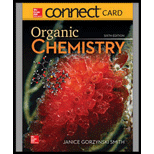
Concept explainers
Give the IUPAC name for each compound, including any R, S designation.
a.  b.
b. 
(a)
Interpretation: The IUPAC name of the given compound, including any R,S designation, is to be stated.
Concept introduction: One should follow the given four steps to give the IUPAC name of a compound. The first step is naming of longest parent chain. The second step is numbering of chain. The third step is naming and numbering of substituents. The fourth step is combining the all parts.
Answer to Problem 39P
The IUPAC name of the given compound is (R)-
Explanation of Solution
The black balls of the given structure represent carbon atoms, the white balls represent hydrogen atoms and the brown ball represent bromine atom. Hence, the complete structure of the compound is,
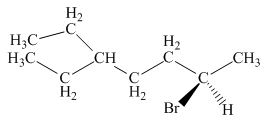
Figure 1
The carbon atom at which bromine atom is attached is chiral in nature. The lowest priority
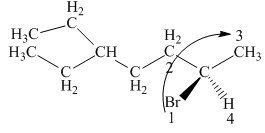
Figure 2
Hence, the configuration of stereogenic center is R.
Bromine group and ethyl group are present on the second and fifth carbon atom, respectively, of a chain of seven carbon atoms as shown in Figure 3.

Figure 3
Therefore, the IUPAC name of the given compound is (R)-
The IUPAC name of the given compound is (R)-
(b)
Interpretation: The IUPAC name of the given compound, including any R,S designation, is to be stated.
Concept introduction: One should follow the given four steps to give the IUPAC name of a compound. The first step is naming of longest parent chain. The second step is numbering of chain. The third step is naming and numbering of substituents. The fourth step is combining the all parts.
Answer to Problem 39P
The IUPAC name of the given compound is (1R)-
Explanation of Solution
The black balls of the given structure represent carbon atoms, the white balls represent hydrogen atoms and the green ball represent chlorine atom. Hence, the complete structure of the compound is,
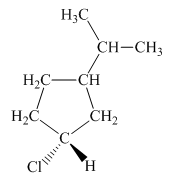
Figure 4
The carbon atom at which chlorine atom is attached is chiral in nature. The lowest priority
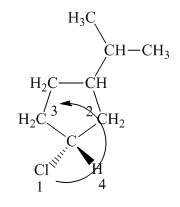
Figure 5
Hence, the configuration of stereogenic center is R.
Chlorine group and isopropyl group are present on the first and third carbon atom, respectively, of a cyclopentane ring as shown in Figure 6.
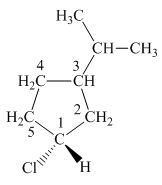
Figure 6
Therefore, the IUPAC name of the given compound is (1R)-
The IUPAC name of the given compound is (1R)-
Want to see more full solutions like this?
Chapter 7 Solutions
ORGANIC CHEMISTRY-ACCESS
Additional Science Textbook Solutions
Applications and Investigations in Earth Science (9th Edition)
Physical Science
Biology: Concepts and Investigations
General, Organic, and Biological Chemistry - 4th edition
- If 10 mL of a commercial sodium silicate solution is added, the water required to obtain a 20% solids solution (SiO2+Na2O) is added. Indicate the final grams of Na2SiO3.arrow_forwardPlease help me figure out the mechanism with arrows of the following reactionarrow_forwardOrganic Functional Groups Predicting the reactants or products of acetal hydrolysis termine the structures of the missing organic molecules in the following reaction: H* H* + H₂O Y ☑ Note: Molecules that share the same letter have the exact same structure. In the drawing area below, draw the skeletal ("line") structures of the missing organic molecules X, Y, and Z. You may draw that you like, so long as they aren't touching. Molecule X shows up in multiple steps, but you only have to draw its structure Explanation Check @2 W Click and drag to start drawing a structure. #4 # 3 LU E % 67 olo 5 66 R T Y & 7 AcGraw Hill LLC. All Rights R Xarrow_forward
- 8. (16 pts) Provide the stepwise mechanism for the synthesis of the following compound via an enaminearrow_forwardDraw the titration curve of (i) weak acid vs. strong base; (ii) weak acid vs. weakbase; (iii) diprotic acid with strong base (iii) triprotic acid with strong base.arrow_forwardComplete the reaction in the drawing area below by adding the major products to the right-hand side. If there won't be any products, because nothing will happen under these reaction conditions, check the box under the drawing area instead. Note: if the products contain one or more pairs of enantiomers, don't worry about drawing each enantiomer with dash and wedge bonds. Just draw one molecule to represent each pair of enantiomers, using line bonds at the chiral center. More... No reaction. my ㄖˋ + 1. Na O Me Click and drag to start drawing a structure. 2. H +arrow_forward
- Predict the intermediate 1 and final product 2 of this organic reaction: NaOMe H+ + 1 2 H H work up You can draw 1 and 2 in any arrangement you like. Note: if either 1 or 2 consists of a pair of enantiomers, just draw one structure using line bonds instead of 3D (dash and wedge) bonds at the chiral center. Click and drag to start drawing a structure. X $ dmarrow_forwardPredict the major products of this organic reaction: 1. NaH (20°C) 2. CH3Br ? Some notes: • Draw only the major product, or products. You can draw them in any arrangement you like. • Be sure to use wedge and dash bonds where necessary, for example to distinguish between major products that are enantiomers. • If there are no products, just check the box under the drawing area. No reaction. Click and drag to start drawing a structure. G Crarrow_forwardPredict the major products of this organic reaction: 1. LDA (-78°C) ? 2. Br Some notes: • Draw only the major product, or products. You can draw them in any arrangement you like. . • Be sure to use wedge and dash bonds where necessary, for example to distinguish between major products that are enantiomers. • If there are no products, just check the box under the drawing area. No reaction. Click and drag to start drawing a structure. Xarrow_forward
- Please draw the structuresarrow_forwardDraw the missing intermediates 1 and 2, plus the final product 3, of this synthesis: 0 1. Eto 1. Eto- 1 2 2. MeBr 2. EtBr H3O+ A 3 You can draw the three structures in any arrangement you like. Explanation Check Click and drag to start drawing a structure.arrow_forwardDraw the missing intermediate 1 and final product 2 of this synthesis: 1. MeO- H3O+ 1 2 2. PrBr Δ You can draw the two structures in any arrangement you like. Click and drag to start drawing a structure.arrow_forward
 ChemistryChemistryISBN:9781305957404Author:Steven S. Zumdahl, Susan A. Zumdahl, Donald J. DeCostePublisher:Cengage Learning
ChemistryChemistryISBN:9781305957404Author:Steven S. Zumdahl, Susan A. Zumdahl, Donald J. DeCostePublisher:Cengage Learning ChemistryChemistryISBN:9781259911156Author:Raymond Chang Dr., Jason Overby ProfessorPublisher:McGraw-Hill Education
ChemistryChemistryISBN:9781259911156Author:Raymond Chang Dr., Jason Overby ProfessorPublisher:McGraw-Hill Education Principles of Instrumental AnalysisChemistryISBN:9781305577213Author:Douglas A. Skoog, F. James Holler, Stanley R. CrouchPublisher:Cengage Learning
Principles of Instrumental AnalysisChemistryISBN:9781305577213Author:Douglas A. Skoog, F. James Holler, Stanley R. CrouchPublisher:Cengage Learning Organic ChemistryChemistryISBN:9780078021558Author:Janice Gorzynski Smith Dr.Publisher:McGraw-Hill Education
Organic ChemistryChemistryISBN:9780078021558Author:Janice Gorzynski Smith Dr.Publisher:McGraw-Hill Education Chemistry: Principles and ReactionsChemistryISBN:9781305079373Author:William L. Masterton, Cecile N. HurleyPublisher:Cengage Learning
Chemistry: Principles and ReactionsChemistryISBN:9781305079373Author:William L. Masterton, Cecile N. HurleyPublisher:Cengage Learning Elementary Principles of Chemical Processes, Bind...ChemistryISBN:9781118431221Author:Richard M. Felder, Ronald W. Rousseau, Lisa G. BullardPublisher:WILEY
Elementary Principles of Chemical Processes, Bind...ChemistryISBN:9781118431221Author:Richard M. Felder, Ronald W. Rousseau, Lisa G. BullardPublisher:WILEY





